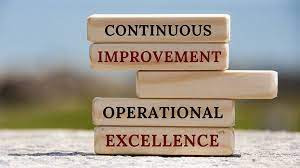The most
successful companies are never satisfied with the status quo. They constantly
have their eye on the next innovation, the next level of performance. They know
the importance of continuous improvement in all areas of the business.
Even if things
are going really well, people at successful organizations are looking at what
could be improved upon so that they can perform better. They are finding ways
to work smarter, not harder, in order to be more efficient and profitable. The
most successful companies are always innovating and developing new ways to
deliver top-notch quality to their customers.
But this kind
of behavior doesn’t just happen. Sure, some people have a natural drive to keep
improving their skills and the results they produce at work. But many people
prefer to stay in their comfort zones, never questioning the way things are
done.
Continuous
improvement is an ongoing process of identifying, analyzing, and making
incremental improvements to systems, processes, products, or services. Its
purpose is to drive efficiency, improve quality, and value delivery while
minimizing waste, variation, and defects. The continual improvement process is
driven by ongoing feedback, collaboration, and data.
Let’s look at
10 rules for effective continuous improvement:
1. Be Open
Minded
An open mind
leads to new possibilities. New possibilities lead to new thoughts and
experiences. To have an open mind means being
flexible and adaptive to new experiences and ideas. Having an open mind doesn’t mean accepting
everything as truth, but rather being open to new possibilities. New thoughts
and experiences lead to growth.
2. Start with
the 3 “Actual” Rule
Continuous
improvement starts with the three “Actual” Rule.
Go to the actual place where the
process is performed.
Talk to the actual people involved in
the process and get the real facts.
Observe and chart the actual process.
All too often,
attempts are made to solve problems without knowing anything about or are not
being familiar with a particular area or process -- resulting in a misdiagnosis
or failed solution. Answers come from the floor, from the Gemba, where the
condition occurs. You need to go to the real place and experience these
conditions for yourself before being able to take the next steps.
3. Focus on
Process Over People
The most
successful organizations understand that the problem is not people failing to
deliver, but that their organizational processes or systems need to be
improved. If an organization really wants a continuous improvement effort
focused on improving its business, it must celebrate the mistakes and errors
that result from inadequate processes or systems so they can be analyzed and
corrected. Enlightened organizations don’t look for someone to blame; they
identify the problems that inevitably arise and encourage their people to
expose these issues, rather than cover them up.
4. Don’t Seek Perfection,
Try-storm
Don’t spend too
much time talking about a solution, try it!! Try-storming encourages the rapid
development and test of an idea rather than merely thinking about the possible
solutions. It allows people to visualize, touch and further improve on an
initial idea. It also models action rather than talk. Often in our desire to
design the perfect Future State we forget that the best way to build a process
that works is through the iterative process of trying, adjusting/correcting,
and trying again.
The process is
built on three basic principles:
- It is not
important to create perfect solutions.
- Be
action-oriented.
- Keep solutions
simple.
5. Creativity Before
Capital
Don’t
substitute money for thinking. In other words, before spending money on a
typical solution (buying equipment, hiring staff, working overtime), try using
existing equipment and employees.
In reality,
even creative solutions may require some investment. Yet, often that investment
is quite small in comparison to more traditional approaches. As Lean
practitioners, it is our job to minimize waste in all that we do – and that
includes the cost associated with solutions.
6. Problems are
Opportunities
The workplace
is full of problems and we are expected to solve them. Problems often stir up
the emotions of everyone involved. When a problem occurs, instead of first
exploring how to get the problem to go away, first stop and ask yourself: What
is the opportunity here? This is the key to innovative problem solving. It’s
understanding that the problems you face are opportunities — no matter how frustrating
they appear to be at first. Innovative thinking on how to solve a difficult
problem begins when you view problems as opportunities — when you break the
barriers of limited thinking that we all have.
7. Focus on the
Root Cause, Not the Symptoms
It’s very easy
to get caught up in the symptoms of the problem and most problems are
incorrectly attempted by suppressing these symptoms. We should resist this
temptation! When we encounter a symptom, it should serve as a prompt to dig
deeper to get at the real root causes for an issue. There are a number of
methods of root cause analysis, including failure mode analysis, fault tree
analysis, and fishbone diagrams. For diagnosing performance issues, one of the
simplest and most effective methods is the "5 Whys," which is
attributed to Taiichi Ohno and his Toyota Production System. This technique
simply requires us to ask why repeatedly until root causes are uncovered.
8. Rely on Data,
Not Opinions
As the
legendary engineer W. Edwards Deming put it, “Without data, you’re just another
person with an opinion.” Without insight into data, people make decisions based
on instinct, speculation, or prevalent theory. People are at risk of acting on
biases or false assumptions. Now, data driven decision making involves
collecting data, performing analysis, and basing decisions on insights derived
from that analysis. This provides for accountability and transparency. Basing
decisions on data allows the logic behind determinations to be transparent and
provides stronger evidence to support those decisions. Data provides context
and knowledge.
9. Practice
Respect
Show respect”
is perhaps the most valuable rule, as people are the goal, not simply the means
to an end. Improvements are accomplished by people, not processes. Processes
ought to be designed to support people in their accomplishment of specific objectives.
Ultimately this means developing people to be who they can be. One tremendous
side effect of that development is greatly increased capability in fulfilling
their roles, which leads to greater efficiency in accomplishing improvement.
10. There is no
destination on the road to improvement
Continuous
improvement is a journey that never ends. There will always be a gap between
where you are (current state) and where you would like to be (True North).
Since there will always be a gap, there will always be an opportunity to
improve. The road to continual improvement can be a rocky one with many ups and
downs. Failure will occur. It’s ok, the purpose is learning, and we learn
through experimentation. Trying new approaches, exploring new methods and
testing new ideas for improving the various processes is exercise for the mind.
Adopting a
culture of continuous improvement can benefit both you, your team and your
business. Finding a suitable way to begin your never-ending quest toward it
doesn’t need to keep you awake at night. Why don’t you start by implementing
these 10 rules in order to set yourself up for all the benefits that come hand
in hand with improving continuously!














